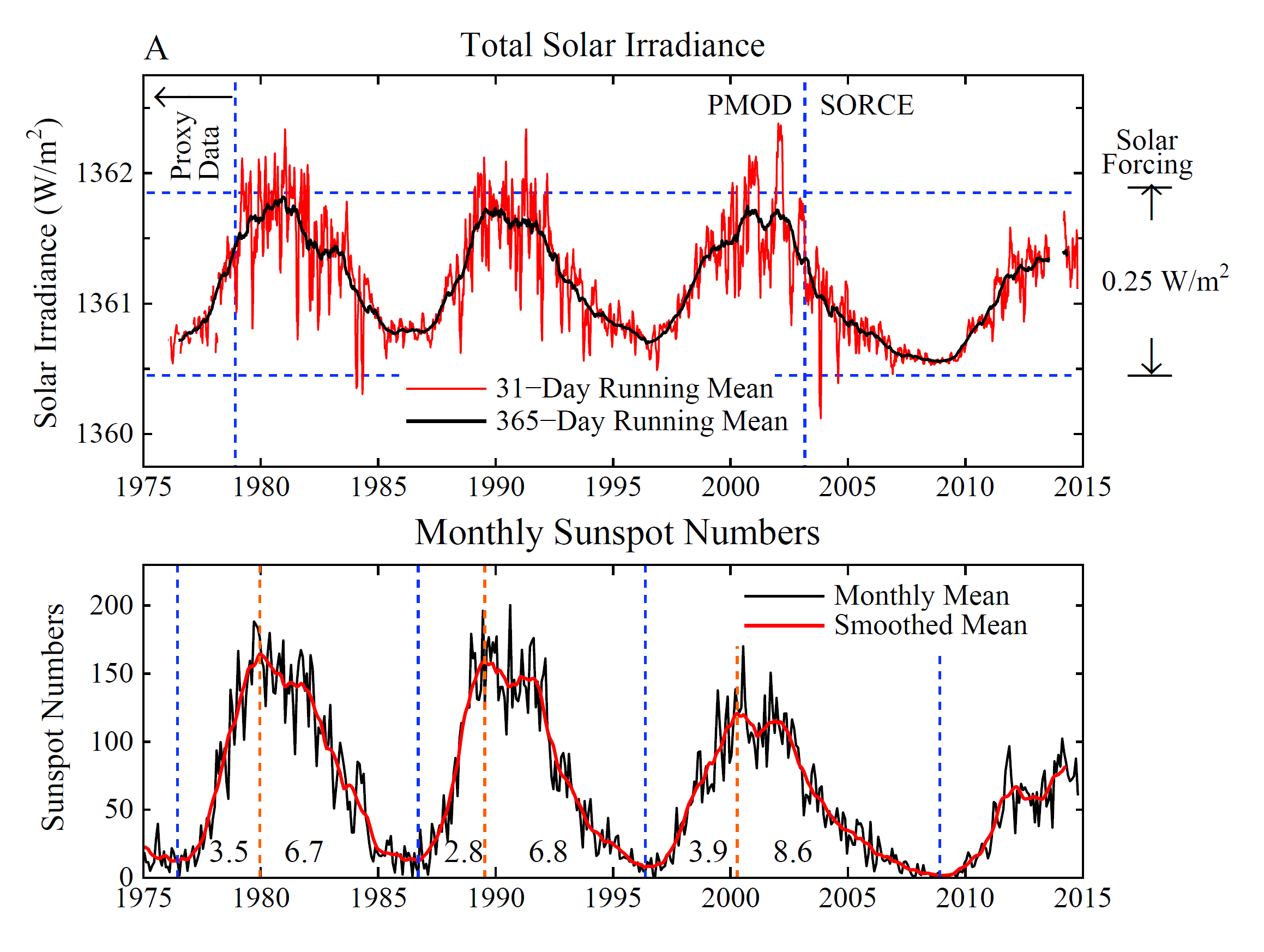RollingThunder
Gold Member
- Mar 22, 2010
- 4,818
- 525
- 155
dude we were currently experiencing a solar minimum.That makes no sense, JustCrazy. The sun's energy "input" into our planet has NOT significantly "decreased", nor has it increased. Crick was right, you are full of shit!nice except that it isn't what I stated I stated that the sun's input is decreased, meaning in your little analogy there that less water is coming into the tank. My gawd, then the tank isn't going to fill and the output will not increase and pressure will not build. wow.It is not "his hypothesis". It is the greenhouse effect and it has been accepted science for over 100 years. Incoming short wave radiation is absorbed by gases in the atmosphere and then re-radiated in all directions as long wave infrared. That process slows the escape of thermal energy from the atmosphere to space and that raises the equilibrium temperature of the system as a whole. Imagine a water tank with a pipe adding more water at a constant rate. Water in the tank rises. Now we put a drain line in at the bottom. The flow of water through the drain line depends on the water pressure - the level of water in the tank. The tank will fill till the water's hydrodynamic pressure creates a flow in the drain line that exactly matches the incoming flow: equilibrium. Now, with a valve we add some restriction to the drain line so that the flow out is reduced. The water level will begin rising again and will not stop till the increased pressure causes the drain line's flow to once more match the rate of incoming water. The tank is the Earth's atmosphere, the water represents the sun's energy, the restriction in the drain line represents the effects of greenhouse gases like CO2 and the water's level is the temperature of the Earth's atmosphere. Got it?
Solar Radiation, Earth's Atmosphere, and the Greenhouse Effect.
Columbia University
SO WHAT?
I just told you that: "The sun's energy "input" into our planet has NOT significantly "decreased", nor has it increased."
Solar minimums have only a minimal effect on the Earth's temperatures....and that effect is completely overwhelmed by the effects of the risings levels of CO2 and methane.
To what extent does the Sun's variability affect and/or cause global climate change?
Stanford Solar Center
(excerpts)
For decades, scientists have tried to understand the link between winds and temperature and the Sun and its cycles. There were tell-tale signs of a connection. For instance, the Little Ice Age recorded in Europe between 1550 and 1700 happened during a time of very low solar activity.
Solar scientists have long known that solar variability changes the distribution of energy in the Earth's atmosphere. During the Sun's 11-year cycle, from solar maximum through solar minimum, the energy released by the Sun changes by only about a tenth of a percent. New studies have clarified that when the solar cycle is at a maximum, it puts out a larger percentage of high-energy radiation, which increases the amount of ozone in the upper atmosphere. The increased ozone warms the upper atmosphere and the warm air affects winds all the way from the stratosphere (that region of the atmosphere that extends from about 6 to 30 miles high) to the Earth's surface. The change in wind strength and direction creates different climate patterns around the globe.
However, according to Drew Shindell, a climate researcher from NASA's Goddard Institute for Space Studies in New York, NY, the most recent studies have confirmed that changing levels of energy from the Sun are not significant enough to be a major cause of global warming: "...the solar increases do not have the ability to cause large global temperature increases...greenhouse gases are indeed playing the dominant role... The Sun is once again less bright as we approach solar minimum, yet global warming continues." For more details, see Link Between Solar Cycle and Climate is Blowin' in the Wind
You might also like to read the paper Solar Irradiance Since 1874 Revisited by S. K. Solanki and M. Fligge, Geophysical Research Letters, vol. 25, no. 3, pages 341-344 (1 Feb 1998)




 Obviously -- your questions gave you away... Waste of time for both of us.. Probably MORE of a waste of our time than going over back-rad with the bat-shit crazy deniers in this forum..
Obviously -- your questions gave you away... Waste of time for both of us.. Probably MORE of a waste of our time than going over back-rad with the bat-shit crazy deniers in this forum.. 